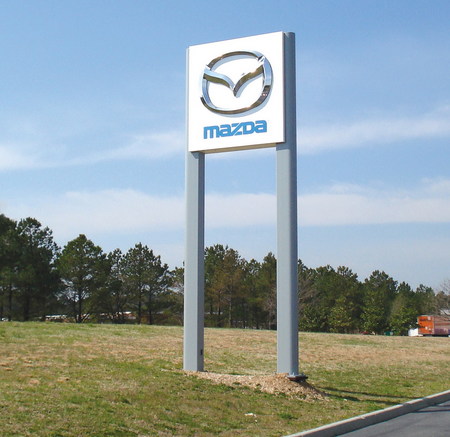The sign-fabrication process has always been an arduous, time-consuming task. When considering appropriate hardware, numerous factors arise, such as the fixtures’ expansion and contraction coefficients, their interaction with the sign substrate, and the time-consuming process of fastening or riveting hardware in place.
Today, fabricators and installers may use an additional option. Though they aren’t suitable for all applications, engineered adhesives may supplant traditional hardware as the structural-bond media. An adhesive-manufacturer representative, and a sign company that frequently opts for adhesive bonding instead of mechanical fasteners, discuss their potential and limitations.
Background
Scott Miller, whose background emphasized mechanical engineering, serves as marketing manager for Lord Adhesives’ (Cary, NC) industrial assembly and components division. He said his training applies to adhesive engineering because both underscore mechanical strength and understanding material properties.
Although adhesives have been used for approximately 20 years to fasten structural elements, they’ve only recently received widespread adoption.
Advertisement
Richard Sorensen, plant manager for Virginia Beach, VA-based Architectural Graphics Inc. (AGI), also possessed industrial-engineering experience before he joined the sign industry. He said adhesives’ greater efficiency is compelling. “Many improvements have been made with adhesives,” Miller said. “New-generation reformulations have yielded products that can bond more aggressively with the media they adhere, and these materials will cure very quickly and effectively.”
“Using adhesives allows us to eliminate a lot of finishing and assembly work, which saves time,” Sorensen said. “It’s much easier to join sign components and let the adhesive cure than having to grind and refinish.”
Miller echoed, “I don’t have hard-and-fast numbers on the savings adhesives pass on to customers, but, as a rule of thumb, they save 30 to 40% on labor costs. Adhesives also offer aesthetic improvements. With adhesives, fabricators won’t experience the welding burn-through and material warping that can occur with traditional hardware assemblies. The sign industry has been a bit slower than other industries to realize adhesives’ potential for more productivity, but it’s happening more now.”
Miller continued, “Historically, metals posed the most significant challenge to adhesives because of their corrosion potential. Plastics and composite media were more easily joined for that reason.”
Though many adhesive varieties have been used throughout the industry’s history, research and innovations have generated three adhesive classes.
Acrylic-based bonding agents, the newest type, are the most effective materials for joining metals. Acrylics’ primary attributes include minimal surface preparation and bonding aggressiveness (though this trait may be a liability when working acrylic-based adhesives with plastics, because such vigorous adhesion may cause crazing or stress cracks).
Advertisement
Urethane adhesives bond well with plastics, wood and foam, but they aren’t commonly used for metals because they don’t bond well without a primer. Epoxies, the longest-used adhesive type, adhere to metals, plastics, concrete, wood and foam. However, they cure slowly, are prone to become brittle when exposed to low temperatures and are less reliable when used with metal and plastic.
Making the grade
To qualify its adhesives for industrial usage, Lord Corp. subjects them to a battery of tests. Criteria include viscosity, functional temperature range and ability to bond diverse materials. Tests occur under several environmental conditions, such as salt spray, impact and fatigue resistance.
Like most material and component manufactures, the company valued earning the Underwriters’ Laboratories (UL) and comparable Canadian Standards Assn. (CSA) testing-lab listing to confirm compliance with National Electrical Code guidelines. Using testing mechanisms similar to Lord Corp.’s, UL listed the adhesives under UL sections 48 and 746C, which address “Electric Signs” and “Polymeric Materials for Use in Electrical Equipment Evaluations,” respectively. The Canadian authority, CAN/CSA, registered it under Section C22.2 No. 2007-M89, “Portable and Stationary Electric Signs and Displays.”
Proper use
Adhesives require very clean substrates. Sorensen said sandblasting away dirt and impurities to ensure a dirt-free surface may be necessary. Usually, wiping the surface with a clean towel and a rag moistened with isopropyl alcohol will suffice. Because adhesives comprise potentially caustic materials, users should wear protective gloves and clothing, and sufficient ventilation should neutralize potentially noxious fumes and vapors.
Advertisement
In addition to conserving labor time and expense, adhesives offer high shear strength, which ranges from 2,000 to 4,000 psi. Also, adhesives usually function in a broad temperature range – Lord Corp. rates its product to perform in the range from -40° to 338° F – and can spread bond stress across the entire joined area.
Miller touts ease of use as another benefit. Available in appli¬cator-tipped cartridges, adhesives can be applied without measuring and hand mixing (he suggests application in a 3⁄8-in.-thick bead for most jobs, ¾ in. for heavier projects). Also, adhesives repel moisture – an essential for electric-sign components – and can act as fillers where parts are poorly fitted.
Acrylic-based adhesives offer a rapid curing timeframe. Sorensen said his shop typically allows adhesives to form an initial cure for five to 10 minutes, and then clamp materials in place for an additional 20 to 60 minutes before removing the clamps and proceeding with fabrication. Miller said faster versions, which only require 10 minutes of clamp time, exist, but such products often set too quickly to allow users time to position parts.
Sorensen said AGI began specifying adhesives to join smaller sign components, such as directional and room-ID placards. Satisfied with the results, he expanded their use to storefront signage and support panels. Initially, his company used Lord Corp.’s 201 acrylic adhesive with the No. 4 accelerator.
Since then, the company has shifted to Lord Corp.’s 400 grade of acrylic adhesives, which Sorensen said are more aggressive and compatible with all aluminum and steel. Also, they’re offered as pre-mixed varieties, which reduce potential errors that could result from manual mixing.
Before embarking on an adhesive application, AGI creates a prototype that replicates the sign’s specs to ensure the adhesive’s appropriateness.
Sorensen advised, “The material bonds quickly, so you have to work in one continuous application or you’ll waste material. Plan your work and be organized ahead of time.”
Also, he said adhesives aren’t a panacea for all sign constructions. If a sign is susceptible to high wind loads, AGI still welds its components. Also, Miller said very large faces may require affixing mechanical stiffeners to temper aluminum’s fluctuation and withstand the mechanical stress. An area where a sign has limited contact points with its fasteners would also benefit from welded hardware.



 Photo Gallery2 weeks ago
Photo Gallery2 weeks ago
 Ask Signs of the Times2 weeks ago
Ask Signs of the Times2 weeks ago
 Paula Fargo1 week ago
Paula Fargo1 week ago
 Real Deal5 days ago
Real Deal5 days ago
 Photo Gallery1 week ago
Photo Gallery1 week ago
 Women in Signs2 weeks ago
Women in Signs2 weeks ago
 Women in Signs2 weeks ago
Women in Signs2 weeks ago
 Projects5 days ago
Projects5 days ago










